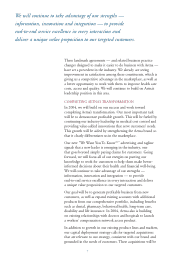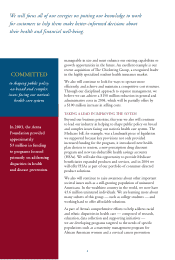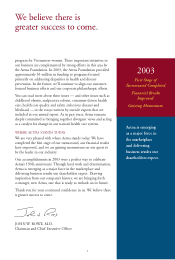Aetna 2003 Annual Report Download - page 17
Download and view the complete annual report
Please find page 17 of the 2003 Aetna annual report below. You can navigate through the pages in the report by either clicking on the pages listed below, or by using the keyword search tool below to find specific information within the annual report.
15
a case where consistent
institutional policy, training,
reinforcement and ready access
to suitable products can save
hundreds, if not thousands,
of lives every year.
Advances in quality can come
from other changes such as
payment linked to quality,
reform in the malpractice
system, better professional
education and a comprehensive
health information
infrastructure. While much
remains to be done, advancing
the quality of care has become
a central objective for many
professional groups, health
and health-related institutions,
employers, payers and
government agencies. No
improvement could be more
fundamental to building
the health care system the
American public deserves.
Individual negligence
accounts for only a tiny
fraction of errors.
Rather, these reports
stress that safety and
quality are properties
of the system of care.
Every year, medical errors account for tens of thousands of
deaths among hospitalized patients in the United States. If these
fatalities were attributable to a new medical condition, it would
rank among the top 10 causes of death in America. According
to a recent, comprehensive study, only about one-half of patients
with chronic conditions actually receive the care they should
(McGlynn et al., N Eng J Med 2003:348:2635-45).
Two reports from the Institute
of Medicine, To Err is Human
(2000) and Crossing the
Quality Chasm (2001),
outline the scope of the
problems of medical errors
and deficiencies in the quality
of care, and point the way to
solutions. Individual negligence
accounts for only a tiny
fraction of errors. Rather, these
reports stress that safety and
quality are properties of the
system of care, and to improve
quality requires fixing the
deficient processes and parts
that produce occasional errors
and poor results. This includes
putting in place mechanisms to
learn from near-misses as well
as bad outcomes; mechanisms
to collect, analyze and act on
experience; and transparency
in the findings. For this,
the health field has much to
learn from others, such as
the airline industry.
Improved technology can
reduce some errors. The most
frequent type of error, for
example, occurs with
medication — the patient
fails to receive the intended
drug in the intended dose at
the right time. Errors occur at
every stage in the medication
process; illegible writing,
erroneous transcription,
overlooking allergy and
contraindications, mislabeling,
and failure in delivery all take
their toll. Computerized
physician order-entry systems,
with automated checking
for contraindications and
allergy, demonstrably reduce
medication errors and
undoubtedly can save lives.
Not every improvement in
safety requires new technology.
The simplest and most
cost-effective way to reduce
hospital-acquired infection,
for example, is by routine
hand cleaning before patient
contact. Yet many studies show
compliance with hand hygiene
by health care workers to be
less than 50 percent. This is
A Safe And High-Quality
Health Care System
























